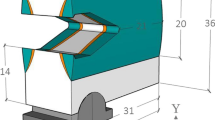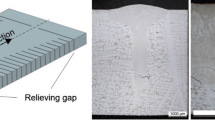Abstract
Despite the ongoing debates on influence of hydrogen uptake and penetration in the steel, pulsed and extraordinary fatigue on white etching cracks (WEC) formation in bearing steel SAE52100, the present paper proposes an alternative hypothesis on electrothermal initiation of the WEC. The hypothesis points to differences between electrical and thermal properties of elements of steel microstructure that lead sequentially to redistribution of current, resistivity heating, thermal expansion and deformations of the carbide particle. Appearance of a nano-void is also predicted by the model in the cases of the martensite and the bainite structures. The model also predicts higher probability of the WEC formation for the bainitic steel.











Similar content being viewed by others
References
Evans, M.H.: White structure flaking in wind turbine gearbox bearings: effect of butterflies and white etching cracks (WEC). Mater. Sci. Technol. 28, 3–18 (2012)
Greco, A., Sheng, S., Keller, J., Erdemir, A.: Material wear and fatigue in wind turbine systems. Wear 302, 1583–1591 (2013)
Rensselar, J.V.: The elephant in the wind turbine, tribology & lubrication technology, June 2010, 38–50 (2010)
Kotzalas, M.N., Doll, G.L.: Tribological advancements for reliable wind turbine performance. Philos. Trans. Ser. A Math. Phys. Eng. Sci. 368, 4829–4850 (2010)
Holweger, W., Wolf, M., Merk, D., Blass, T., Goss, M., Loos, J., Barteldes, S., Jakovics, A.: White etching crack root cause investigations. Tribol. Trans. 58, 59–69 (2015)
ISO 281:2007(E): Rolling bearings—dynamic load ratings and rating life, Second edition (2007)
Ruellan, A., Ville, F., Kleber, X., Arnaudon, A., Girodin, D.: Understanding white etching cracks in rolling element bearings: the effect of hydrogen charging on the formation mechanisms. Proc. Inst. Mech. Eng. Part J: J. Eng. Tribol. 228, 1252–1265 (2014)
Luyckx, J.: White etching crack failure mode in roller bearings: from observation via analysis to understanding and an industrial solution. In: Yoshimi, T., William, M. (eds.) Rolling element bearings, pp. 1–25. ASTM International, Anaheim (2012)
Ruellan, A., Ville, F., Kleber, X., Burnet, C., Liatard, B.: White etching cracks (WEC) in rolling element bearings: influent drivers from wind turbines to laboratory reproduction. Tribol. Lubr. Technol. 70, 14–17 (2014)
Tamada, K., Tanaka, H.: Occurrence of brittle flaking on bearings used for automotive electrical instruments and auxiliary devices. Wear 199, 245–252 (1996)
Evans, M.-H., Richardson, A.D., Wang, L., Wood, R.J.K.: Effect of hydrogen on butterfly and white etching crack (WEC) formation under rolling contact fatigue (RCF). Wear 306, 226–241 (2013)
Gegner, J.: Frictional surface crack initiation and corrosion fatigue driven crack growth. NREL Workshop, Broomfield (2011)
Holweger, W.: Progress in solving white etching crack phenoma. Gearbox reliability collaborative all member meeting, National Renewable Energy Laboratory, Golden, Colorado, USA (2014)
Holweger, W., Wolf, M., Walther, F., Trojahn, W., Mütze, A., Kunzmann, J., Schreiber, J., Mayer, J., Reichelt, M.: Studies of the contribution of alternating electromagnetic fields toward material fatigue in 100Cr6. Ind. Lubr. Tribol. 64, 247–252 (2012)
Pohrer, B., Zürcher, M., Holweger, W., Korth, Y., Wolf, M., Goss, M., Schluecker, E.: In situ IR-Spektroskopie an elektrisch beanspruchten Walzlagern fur White Etching Crack-Untersuchungen, GFT Fachtagung, Göttingen. Vortrag, Tagungsband (2013)
Ščepanskis, M., Jakovičs, A., Kaldre, I., Maniks, J., Nacke, B., and Holweger, W.: Electromagnetic impact on early white etching cracks in inhomogeneous structure of bearing steel. STLE Annual Meeting, Lake Buena Vista, Florida, USA 1, 343–345 (2014)
Bhadeshia, H.K.D.H.: Steels for bearings. Prog. Mater. Sci. 57, 268–435 (2012)
Johnson, R.F., Sewell, J.F.: The bearing properties of 1% C-Cr steel as influenced by steelmaking practice. J. Iron Steel Inst. 196, 414–444 (1960)
West, O.H.E., Diederichs, A.M., Alimadadi, H., Dahl, K.V., Somers, M.A.J.: Application of complementary techniques for advanced characterization of white etching cracks. Pract. Metallogr. 50, 410–431 (2013)
Grabulov, A.: TEM/SEM investigation of microstructural changes within the white etching areas under rolling contact fatigue and 3-D crack reconstruction by focused ion beam. Scr. Mater. 57, 635–638 (2007)
Mitamura, N., Hidaka, H., Takaki, S.: Microstructure development in bearing steel during rolling contact fatigue. Mater. Sci. Forum 539–543, 4255–4260 (2007)
Nakayama, K., Nevshupa, R.A.: Plasma generation in a gap around a sliding contact. J. Phys. D 35, L53–L56 (2002)
Chu, P.S.Y., Cameron, A.: Flow of electric current through lubricated contact. ASLE Trans. 10, 226–234 (1967)
Prashad, H.: Magnetic flux density distribution on the track surface of rolling-element bearings: an experimental and theoretical investigation. Tribol. Trans. 39, 386–391 (1996)
Prashad, H.: Determination of magnetic flux density on the surfaces of rolling-element bearings as an indication of the current that has passed through them: an investigation. Tribol. Int. 32, 455–467 (1999)
Boyd, J., Kaufman, H.N.: The causes and the control of electrical currents in bearings. Lubr. Eng. 15, 28–35 (1959)
Jablonka, K.: The effect of the polarity of the lubricant upon capacitance measurements of EHD contacts. Tribol. Int. 61, 95–101 (2013)
Huber, P., Sonin, A.: Theory of charging in liquid hydrocarbon fluids. J. Colloid Interface Sci. 61, 109–125 (1977)
Qiu, T.Q., Tien, C.L.: Heat transfer mechanisms during short-pulse laser heating of metals. J. Heat Transfer 115, 835–841 (1993)
Kajimura, H., Yamanaka, K.: Effect of chromium carbides on electrical resistivity of nickel based alloys by low temperature aging. Mater. Sci. Technol. 5, 1128–1134 (1989)
Häglund, J., Grimvall, G., Jarlborg, T.: Electronic structure, X-ray photoemission spectra, and transport properties of Fe3C (cementite). Phys. Rev. B 44, 2914 (1991)
Radcliffe, S.V., Rollason, E.C.: Electrical resistivity of high purity Fe-C alloys. J. Iron Steel Inst. 189, 45 (1958)
Masumoto, H.: On the electrical and thermal conductivities of carbon steel and cast iron. Science Reports of the Tohoku Imperial University 16, 417–435 (1927)
Helsing, J., Grimvall, G.: Thermal conductivity of cast iron: models and analysis of experiments. J. Appl. Phys. 70, 1198 (1991)
Lee, M.-C., Simkovich, G.: Electrical conduction behaviour of cementite, Fe3C. Metall. Trans. A 18A, 485 (1987)
Umemoto, M., Liu, Z.G., Takaoka, H., Sawakami, M., Tsuchiya, K., Masuyama, K.: Production of bulk cementite and its characterization. Metall. Mater. Trans. A 32A, 2127–2131 (2001)
Umemoto, M., Todaka, Y., Takahashi, T., Li, P., Tokumiya, R., Tsuchiya, K.: Characterization of bulk cementite produced by mechanical alloying and spark plasma sintering. JMNM 15–16, 607–614 (2003)
Ryttberg, K., Knutsen Wedel, M., Recina, V., Dahlman, P., Nyborg, L.: The effect of cold ring rolling on the evolution of microstructure and texture in 100Cr6 steel. Mater. Sci. Eng. A 527, 2431–2436 (2010)
Acknowledgments
The contribution of Dr. M. Ščepanskis is financially supported by European Social Fund within the Project No. 2013/0018/1DP/1.1.1.2.0/13/APIA/VIAA/061. The contribution of the other co-authors was supported by Schaeffler Technologies GmbH & Co. KG.
Author information
Authors and Affiliations
Corresponding author
Rights and permissions
About this article
Cite this article
Ščepanskis, M., Jakovičs, A., Kaldre, I. et al. The Numerical Model of Electrothermal Deformations of Carbides in Bearing Steel as the Possible Cause of White Etching Cracks Initiation. Tribol Lett 59, 37 (2015). https://doi.org/10.1007/s11249-015-0564-8
Received:
Accepted:
Published:
DOI: https://doi.org/10.1007/s11249-015-0564-8




